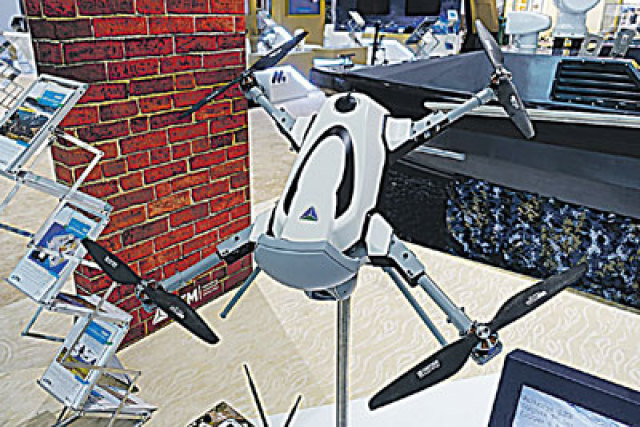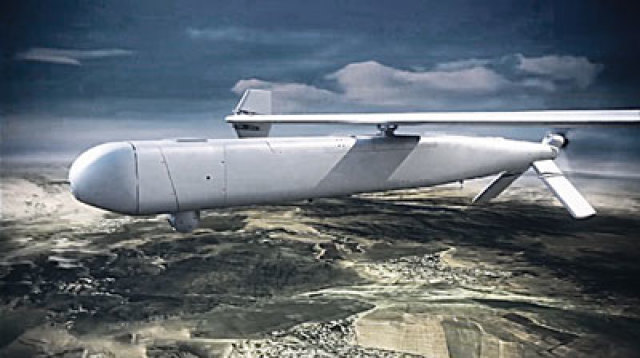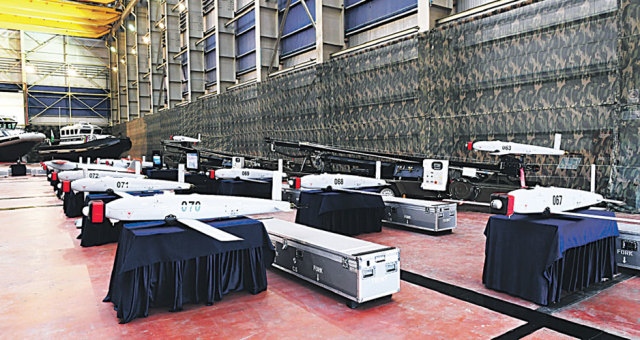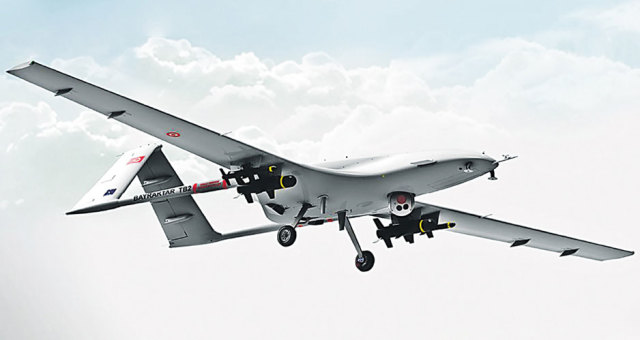The outcome of combat operations in modern warfare is determined by missiles and drones
The Armenian-Azerbaijani conflict in Nagorno-Karabakh seems to have subsided, but the experience of this conflict will be studied by military experts from all countries. First of all, because the most modern weapons were used in the fighting – missiles and unmanned aerial vehicles that caused significant damage to the opposing sides. What lessons and conclusions can be drawn from those fights?
The experience of the first month of combat operations showed that the Armenian army was not able to prepare for the large-scale use of UAVS for various purposes by the enemy.
To feel confident in the skies of Nagorno-Karabakh, Azerbaijan purchased Turkish and Israeli drones. Among them are barraging ammunition, which is also called kamikaze drones. One of them is the newest Alpagu. It weighs only 3.7 kilograms and is operated by a single serviceman. The UAV has a combat radius of five kilometers and is capable of hitting a target by ramming an explosive. Time spent in the air-up to 20 minutes.
In terms of EW
Another Turkish kamikaze drone is the Sky Striker. Its weight is 35 kilograms, of which from 5 to 10 kilograms fall on the warhead. The maximum flight speed is up to 185 kilometers per hour, and the time spent in the air is two hours.
In addition to the Turkish ones, the Azerbaijani army actively used Israeli kamikaze drones. One of them is the IAI Harop. It has a range of up to a thousand kilometers and develops a speed of 185 kilometers per hour. The drone can stay in the air until the operator finds the target, up to six hours. The warhead is 23 kilograms.
Recently, it became known that Israel delivered another kamikaze drone to Azerbaijan-the IAI Mini Harpy. It was developed in 2019. Its weight is 45 kilograms, eight of which are accounted for by the high-explosive warhead. The drone can operate under the control of an operator at a range of up to 100 kilometers and barrage in the air for up to two hours. One of the tasks of Mini Harpy is to fight the s-300P air defense system. The drone is able to detect radiation from an all-altitude detector or radar illumination and guidance. Then the UAV moves precisely along the location beam to the transmitting station and destroys it by ramming and self-detonating. The combat use of the IAI Mini Harpy in many ways resembles the American anti-radar missiles of the Vietnam war – AGM-45 Shrike.
Azerbaijan has also made extensive use of Turkish Bayraktar TB2 attack drones. The drone was developed by the Turkish company Baykar Makina. It is 6.5 meters long and has a wingspan of 12 meters. The maximum take-off weight is about 650 kilograms, and the load capacity is 55 kilograms. The UAV can carry guided anti-tank missiles and aerial bombs, including small mam-L laser-guided ammunition from Roketsan. The maximum speed of the drone is 222 kilometers per hour, cruising speed is 130, and the range is 150 kilometers. Ceiling-up to 8200 meters. The autonomy of flight is more than 24 hours. Thanks to highly sensitive and precise optics, the drone can effectively hit targets from a height of seven kilometers. During tests in late 2015, the Bayraktar TB2 hit a target measuring approximately 3x3 meters from an altitude of 4,800 meters and a range of eight kilometers with a small laser-guided SMM gliding bomb. Turkish developers claim that their drone has more modern control and guidance systems than the Israeli Harop. According to some experts, the cost of one Bayraktar TB2 with a ground control system is approximately five million dollars
With the help of Turkey, Baku itself began assembling iti Qovan-type attack drones, which is an improved version of the Azerbaijani-Turkish Zerbe ("Strike") barrage munition. It is known that the weight of the Zerbe is 10 kilograms, of which the warhead and 4000 striking elements account for two kilograms. The flight range is up to 100 kilometers. Speed – 60-100 kilometers per hour. The maximum ceiling is 4500 meters. The barrage ammunition is launched using a catapult and can stay in the air for up to two hours. In case of return to the operator, the landing is performed using a parachute. The new iti Qovan kamikaze drone has a more powerful warhead. It is capable of operating in conditions of counteraction from electronic warfare systems, as well as in the absence of a GPS signal.
Trying to show the great importance of UAVS in the war in Nagorno-Karabakh, Azerbaijan published a video about the destruction of a mobile three-coordinate radar of the 36D6 (19J6) air space survey using a strike drone. Such a station can be assigned to the s-300PS anti-aircraft missile division if it is Autonomous. The radar was developed in Soviet times and is not an integral part of the complex. Moreover, its ability to detect targets with a small effective reflective surface leaves much to be desired.
You can also find on the Internet footage of the destruction of the Israeli-made Mini Harpy SAM S-300P of the Armenian army ("MIC", No. 41). The quality of the recording does not allow us to determine whether a real complex was hit or its inflatable rubber mock-up, which is able to imitate the operation of the SAM in many ways. It is important to note that the Armenian air defense system is equipped with the first modification of the complex, which was removed from service in Russia more than 10 years ago as outdated.

Alpagu. Photo: rusnext.ru
Alpagu. Photo: rusnext. successful attacks of attack drones on SAMS of Soviet development say that obsolete air defense systems are unable to effectively resist modern attack UAVS without special protection systems. It must be said that the Armenian air defense units did not have systems to counter anti-radar projectiles and kamikaze drones, such as Gazetchik-E. The protection complex includes an Autonomous device-a detector of anti-radar missiles and kamikaze drones, a distraction device that emits a false signal in the operating range of the protected radar, a device that interacts with the equipment of the protected station, sets up the launch of dipole reflectors and aerosol jamming.
To combat all types of UAVs, Armenian air defense units could use modern modular TOR-M2KM SAMS. They can be placed on a heavy-duty car or crawler chassis. These complexes should protect the Iskander missile defense system, the S-300P air defense system, bridges and other communications. Moreover, the tor-M2KM SAM is capable of intercepting MLRS missiles. However, we did not see the cover of the most important objects, as well as expensive weapons systems and military equipment with the help of quite modern anti-aircraft missile weapons. Most likely, the silence of the "Thors" can be explained by the high cost of anti-aircraft missiles, which were not so many in the Armenian army.
In addition to the modern short-range SAM "tor-M2KM", the Armenian military can use portable anti-aircraft missile systems (MANPADS)" Strela-2"," Igla "of various modifications, as well as the latest MANPADS"Verba". The target range is 4,2/6/6 kilometers, and altitude– 2,3/3,5/3,5 kilometers, respectively. The main difference between the Verba MANPADS is the three-channel tracking of the target, which ensures high noise immunity of the missile. The weak point remains the height of the defeat, which does not allow you to destroy attack drones flying above four thousand meters.
The use of combat helicopters against drones is also problematic, since the helicopter at medium and high altitudes itself becomes a good target for enemy air defense systems.
But the main problem of the Armenian air defense was that it does not have modern zrpc "Pantsir-S1". As combat experience shows, the complex effectively fights all types of drones in Syria. Successfully, the "Shells" are fighting in Libya, especially if they do not act alone, but in cooperation with other air defense systems.

IAI Mini Harpy. Photo: YouTube
IAI Mini Harpy. Photo: Youtubepractics of fighting showed that anti-aircraft guns must necessarily cover each other. In the so-called dead zone, Maxim machine guns were already operating at that time, mounted on special machines and repelling the attacks of aircraft that broke through directly to the anti-aircraft battery.
The layered construction of anti-aircraft air defense systems was then repeatedly tested in world war II, as well as during the Vietnam war and during local conflicts in the middle East.
However, these elementary rules, written in blood at the time, are for some reason periodically ignored by the Arab military in Syria and Libya, as well as by the Armenian rocket men in Nagorno-Karabakh, preferring to use SAMS singly, without mutual cover and echeloned formation. Here you can clearly see the tactics of military air defense, and not the object, which prohibits the use of any type of SAM without mutual cover.
Another important feature of the Pantsir-S1 missile defense system is the relatively low cost of a missile defense system, which is several times less than any other similar missile. In addition, the Shell missile does not leave a heat trace, which greatly annoys the NATO developers of combat aircraft, cruise missiles and drones. This also explains the mass of fakes addressed to the Pantsir-S1 zrpc in the Turkish media, as well as on the website of the Ukrainian information and consulting company defense Express, fakes from which are often reprinted by some Russian network resources.
There are no modern electronic warfare systems in the Armenian army, which have been showing their high efficiency in the fight against drones in Syria for years.
Vulnerability
Azerbaijan has also purchased long-range rocket and artillery systems from Turkey, Israel and several other countries to launch attacks deep inside the territory of unrecognized Nagorno-Karabakh. The LORA mobile otrk was developed by Israel Aerospace Industries (IAI). The missile has a range of up to 300 kilometers. Thanks to the GPS system, the circular probable deviation from the target does not exceed 10 meters. The missile flies along a ballistic trajectory, reaching a maximum altitude of 45 kilometers, which complicates the operation of some air defense systems. The weight of the warhead depends on the range of the flight, the type of target and can vary in the range from 240 to 600 kilograms. According to some reports, Azerbaijan has purchased up to 50 LORA missiles.
In December 2017, Israel used the LORA complex to fire at a military base in Syria. The missile was successfully intercepted by the Pantsir-S1 zrpc, after which tel Aviv refused to accept the otrk into service with its army and began actively promoting it for sale abroad. The only country that bought the LORA complex was Azerbaijan, which uses IT to launch attacks on the rear facilities of Nagorno-Karabakh. Thus, the LORA missile system was able to disable part of the strategically important bridge over the Akari river in the Lachin area. The bridge connects the mountainous regions of Karabakh and Armenia and is of fundamental importance for the operation of the highway.

Sky Striker. Photo: livejournal.com
In addition to the Israeli otrk, Baku acquired 60 Turkish t-122 Sakarya MLRS ("Sakarya») caliber 122 mm, which in many ways are analogous to the Soviet BM-21 "Grad". The maximum range is 40 kilometers. Another variant of the BM-21 Grad MLRS is the Czech RM-70 Vampire MLRS of 122 mm caliber. By the beginning of the conflict, the Azerbaijani army had 73 combat vehicles of this type.
At one time, Israel supplied Azerbaijan with 80 Lynx MLRS with launch modules of various calibers – from 122 to 300 millimeters. The range of fire, depending on the type of missiles, is 20, 40 and 150 kilometers.
The Lynx MLRS can use special EXTRA modules that are designed for 306 mm missiles. The missiles are developed by the Israeli company Israel Military Industries (IMI), their firing range is determined by the modification of the missile and can reach 150 kilometers. The weight of the warhead is 125 kilograms. When the missile is guided using GPS, the circular probable deviation does not exceed 5-10 meters. The Azerbaijani army has 30 extra modules.
In addition to the MLRS, Baku purchased from Israel five self-propelled howitzers (battery) on the ATMOS 2000 wheeled chassis of 155 mm caliber with a range of 30 kilometers, and when using active-rocket projectiles – 41 kilometers.
More recently, photos appeared in the media of a division of Czech-made self-propelled guns "Dana" being moved to the combat area. According to the main characteristics, the Dana gun is an analog of the 152 mm acacia 2S3 self-propelled gun. Unlike the Soviet self-propelled howitzer, the Czechs used a wheeled chassis based on the Tatra car, as well as a NATO 155 mm caliber.
Azerbaijan also took care of updating its air defense system by purchasing the Israeli SPYDER SR short-and medium-range air defense system. The complex can fire two types of missiles – Python-5 and DERby. The first has a range of 20 kilometers and destroys targets at an altitude of 9 kilometers. The second missile can hit aerodynamic targets at a range of up to 50 kilometers and an altitude of up to 16. Both missiles allow you to shoot on the principle of "shot-forgot". To do this, the Python-5 rocket uses infrared homing in conjunction with an electron-optical image. Active radar homing is used in the Derby missile defense system.
Another Israeli air defense system that is in service with the Azerbaijani air defense system is the Barak-8. In total, there is one division consisting of nine launchers and 75 missiles. The station of the complex is equipped with an active phased array antenna. The SAM has an inertial guidance system that directs the missile to the desired square of space. Then the active homing head is activated, allowing the missile to find the target independently. This method of targeting allows you to hit radar invisible targets located beyond the horizon. When launching a rocket, a vertical launch is used from a transport and launch container. The missile defense system uses a smokeless solid-fuel engine, which significantly complicates the visual detection of the starting position by enemy aircraft. The SAM is capable of destroying aerodynamic targets at a range of 70-90 kilometers and at altitudes of up to 16 kilometers.
If we talk about armored vehicles, the vehicles of the Armenian and Azerbaijani armies are equipped with an outdated system of dynamic protection "Contact". It is unable to protect the tank from a kamikaze drone or a cornet missile attack with a cumulative tandem warhead. Armenia and Azerbaijan are not yet talking about the active protection complex (KAZ) of arena-M armored vehicles, which can destroy an American FGM-148 Javelin or Israeli Spike missile on approach. And it's not just the price of KAZ, although this also plays a role. It's just that the Azerbaijani and Armenian armored units fought the war as if it was still the end of the twentieth century on the street.
Yuri Knutov
Military-industrial courier newspaper, published in issue # 44 (857) for November 17, 2020


